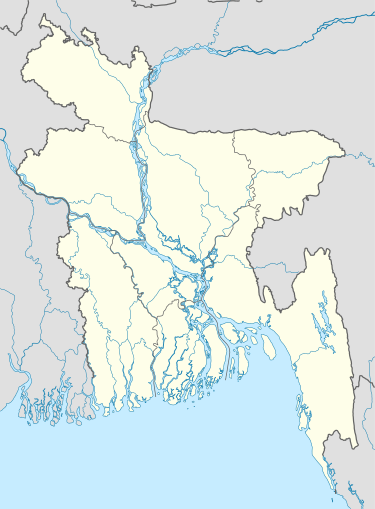Hatiya Upazila
| Hatiya হাতিয়া | |
|---|---|
| Upazila | |
 Hatiya Location in Bangladesh | |
| Coordinates: 22°22′N 91°7.5′E / 22.367°N 91.1250°ECoordinates: 22°22′N 91°7.5′E / 22.367°N 91.1250°E | |
| Country |
|
| Division | Chittagong Division |
| District | Noakhali District |
| Area | |
| • Total | 1,507.23 km2 (581.94 sq mi) |
| Population (2011 census) | |
| • Total | 453,987 |
| • Density | 300/km2 (780/sq mi) |
| Time zone | BST (UTC+6) |
| Postal code | 3890 |
| Website |
hatia |
| Dilir | |
Hatiya (Bengali: হাতিয়া) is an upazila, or sub district, of Noakhali District in the Division of Chittagong, Bangladesh.[1] An island with the same name is located within this upazila, as is Nijhum Dwip, another smaller island.
Geography
Hatiya Upazila is located at 22°22′00″N 91°07′30″E / 22.3667°N 91.1250°E. It has 47,970 household units and a total area of 1,508.23 square kilometres.
Demographics
At the 2011 Bangladesh census, Hatiya had a population of 452,987. Males constituted 50.73% of the population and females constituted 49.27%. The population over age 18 was 125,512. Hatiya had an average literacy rate of 21% (7+ years), against the national average of 32.4%.[2]
Economy
The upazila consists of 52 markets and bazaars. They include Oskhali, Afazia, Tamruddi, Chowmuhani, Sagaria, Jahajmara, Sonadia chowrasta, Char Chenga and Nalchira Bazar. Most people are employed in agriculture and fishing, and a few professions are government or non-governmental jobs. All banks are run by the government, including Krishi Bank, Sonali Bank, and Jonota Bank.
The main exports include rice, coconut, betel nut, banana, betel leaf, chili, Hilsa, and other types of fish.
Administration
Hatiya has 10 unions: Boyar Char(Horni),Noler Char & Carrying Char (Chanondi), Char King, Char Ishwar, Tamaruddi, Burir Char, Sonadia, Jahajmara, and Nijhum Dwip (recently established). There are 53 Mauzas/Mahallas and 69 villages in this upazila.
Healthcare
There is one Upazila Health Complex and 10 family planning centres. Notable NGOs operating in this area are Grameeen bank, Dwip unnoyan songstha, Brac, Proshika,Heed Bangladesh, CARE, and Caritas.
Education
Institutions of higher education include Hatiya Dwip Government College and three non-governmental colleges.
See also
- Upazilas of Bangladesh
- Districts of Bangladesh
- Divisions of Bangladesh
- List of islands of Bangladesh
References
- ↑ Md Tawhid Hussain Chowdhury (2012). "Hatiya Upazila". In Sirajul Islam and Ahmed A. Jamal. Banglapedia: National Encyclopedia of Bangladesh (Second ed.). Asiatic Society of Bangladesh.
- ↑ "Population Census Wing, BBS.". Archived from the original on 27 March 2005. Retrieved 10 November 2006.
